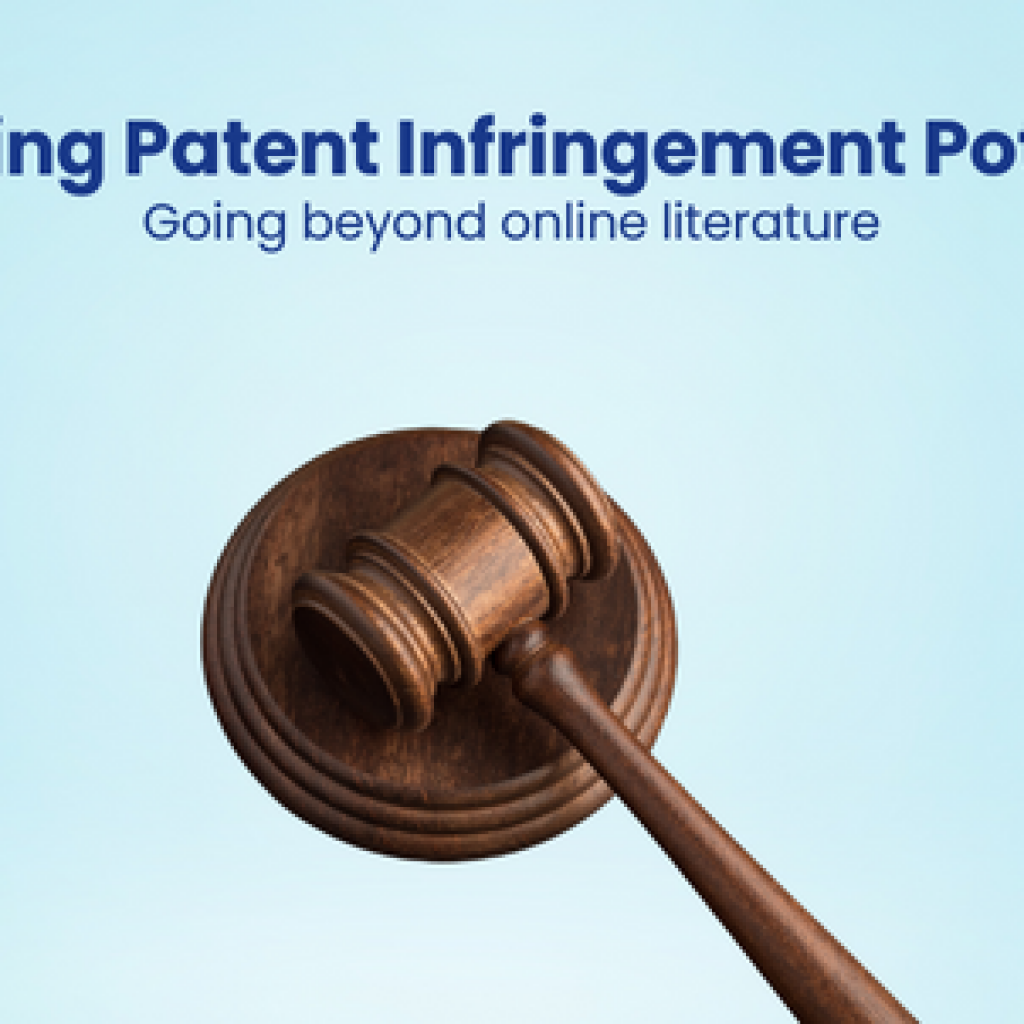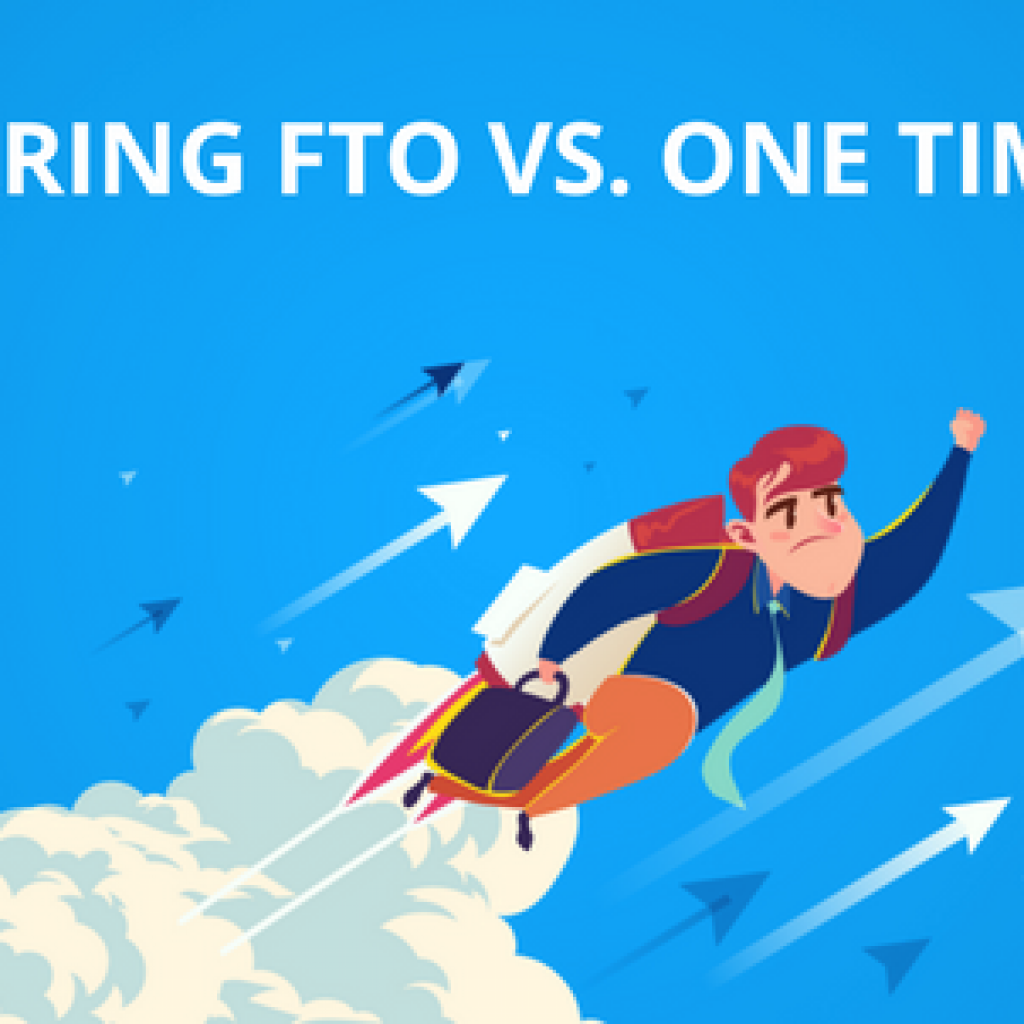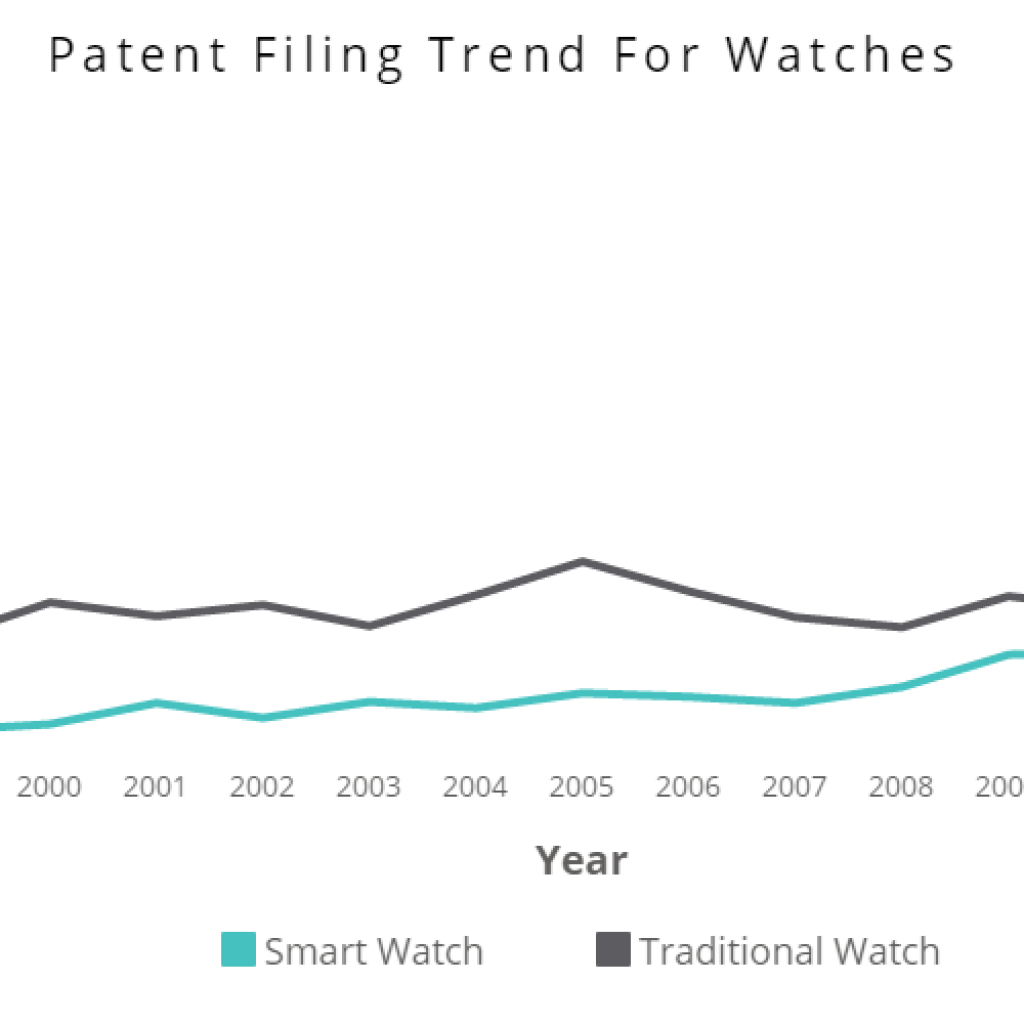This is the second part of our 3-part V2X series. But before we go ahead, let’s take a quick recap. In the first part, we talked about how V2X communication is going to change the world for good. We then saw how the V2X market is doing both in terms of C-V2X and WLAN-V2X and why the majority of companies are adopting C-V2X? And conclude with the future outlook of V2X.
Today, we will talk about the companies leading the V2X research including both Cellular and WLAN-based connectivity, and discover what lies inside the patent portfolio of these top players. So without any further ado, let’s jump to it.
Companies with Most V2X Patents
As a Patent Analytics firm, we include patent insights along with market research to find the big picture, the holistic view. It gives the most needed clarity to the research angle that one would miss if they rely only on either market research OR patent analysis. So, we started digging into the top 10 companies with the most V2X patents including C-V2X, V2V, V2I, V2N, V2C, V2P, V2D, etc.
Below are the results we found.
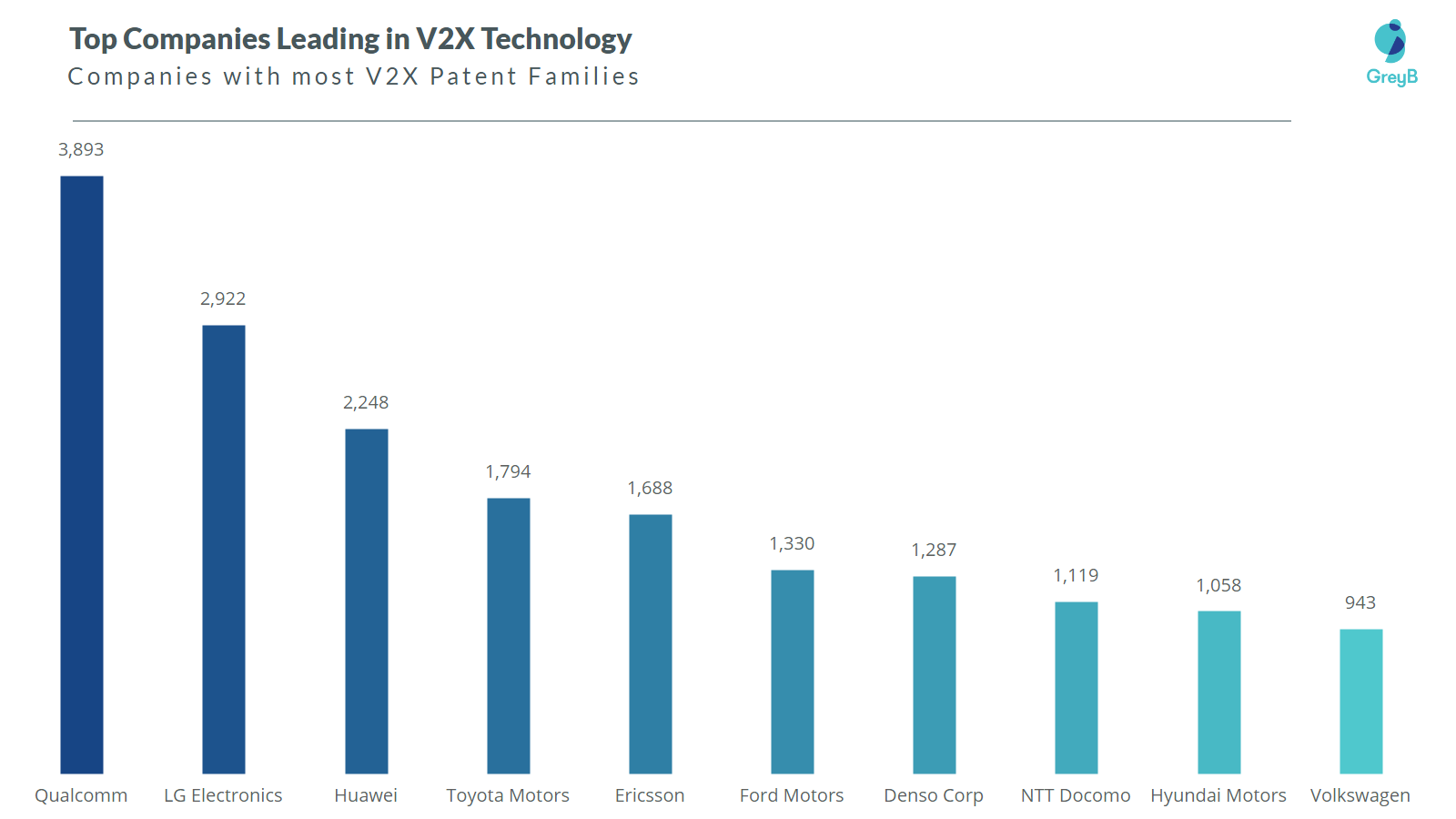
From patent analytics, Qualcomm is the top company with the 3893 V2X patent families in its portfolio. LG is trailing behind in the 2nd spot with almost 3000 patent families. Next to LG comes Huawei, the only Chinese company in the top 10 list with 2248 patent families.
Another interesting fact is that the technology companies are leading in the V2X patent count while automotive players are trailing. In the top 10 list, there are 5 tech companies and 5 automakers, but in the top 5 list, there are 4 tech companies while just 1 automaker. But isn’t V2X one of the main advancements in the automotive world? Then why?
Well, the main reason tech companies are leading is of course the C-V2X where these tech companies are leading in the patent count. In the last article, we have seen that there is more research happening on C-V2X than WLAN-V2X. So, keeping that in mind, we made a list of the top 10 companies working in C-V2X technology.
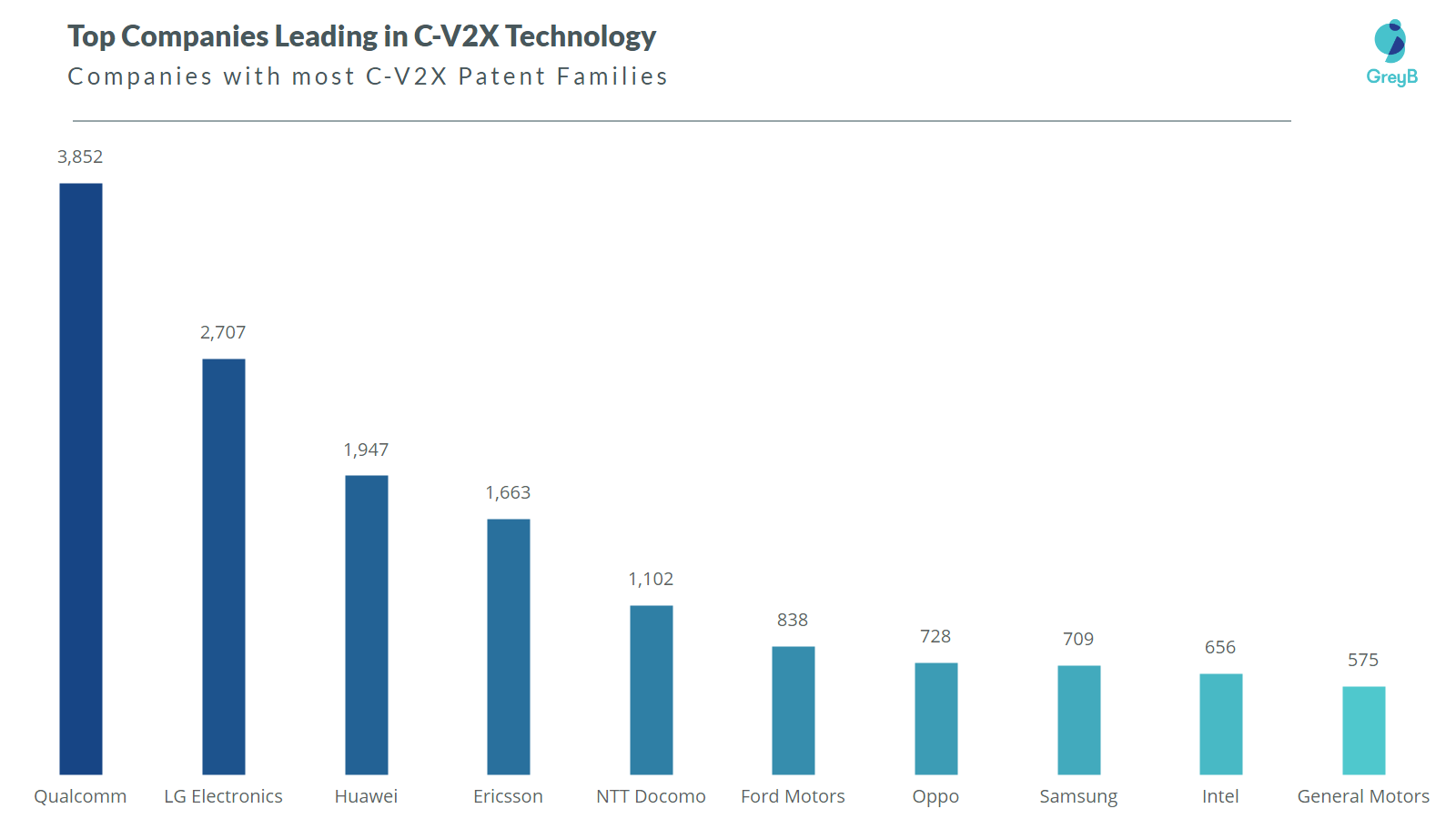
In this list, if you notice there are only two automotive companies.
But, here’s when it gets interesting as well as justified.
Look at the WLAN-Based V2X patents chart below, the picture is flipped.
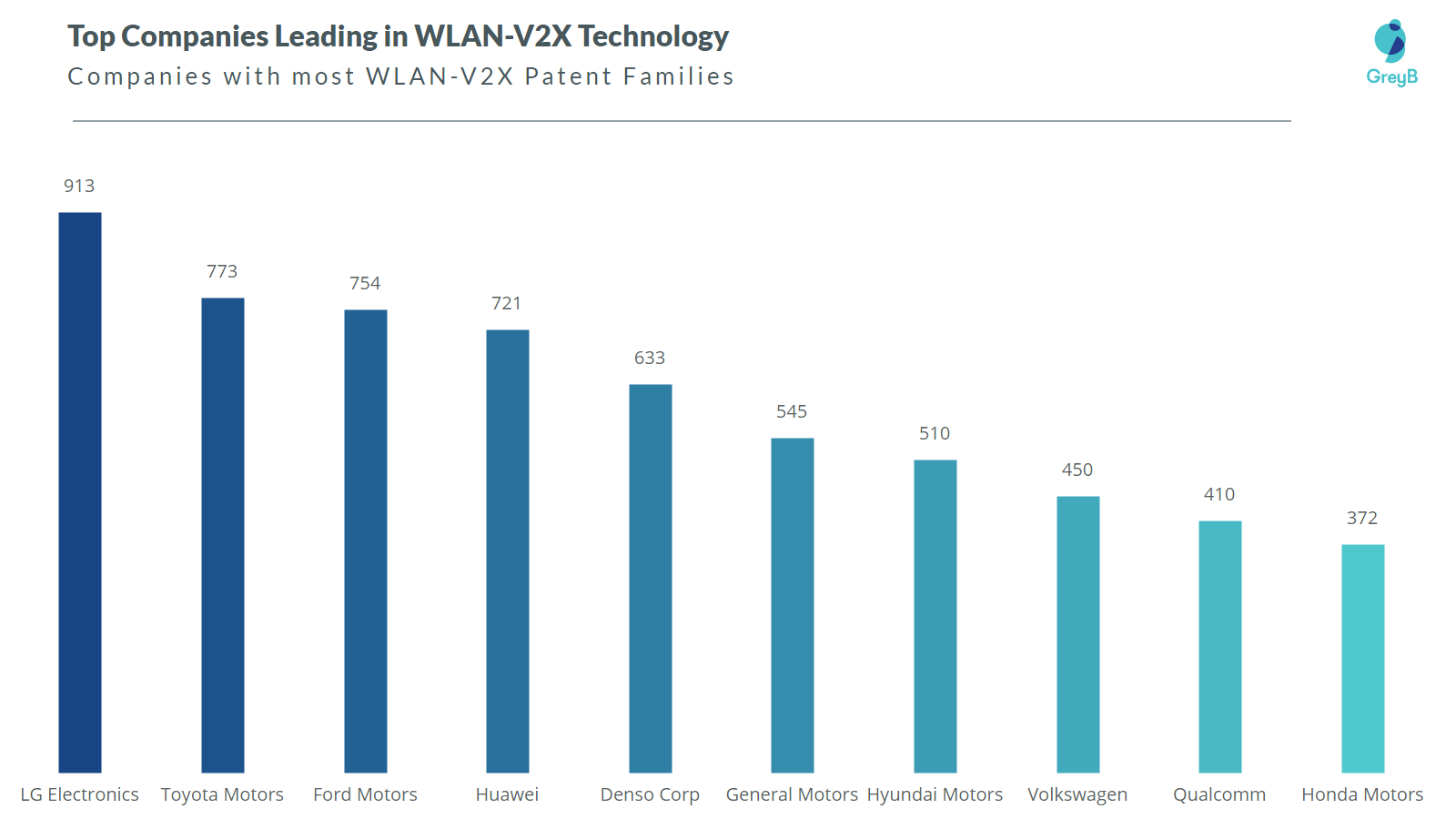
In the top 10 list, there are 7 automotive companies and just 3 technology companies with LG being the top one. So, it pretty much sums up that for automotive companies short distance communication is an easy bet, thus WLAN-V2X.
But since we are discussing the top V2X players, we have picked the companies that are leading in overall V2X research including both C-V2X and WLAN-V2X regardless of their core industry.
Major V2X Companies
1. LG
Since 2017, LG and Qualcomm have been cooperatively researching and developing next-generation connectivity solutions for vehicles. The two companies have even established a joint research center in South Korea for developing 5G for vehicle and C-V2X technologies which are crucial to the success of next-generation autonomous vehicles. LG Electronics, being a pioneer in V2X innovations, has been the industry leader within the fast-growing telematics market since 2013.
“Building on our long-standing relationship with LG, this effort to advance C-V2X technology further demonstrates our continued commitment to the development of advanced solutions for safe, connected, and increasingly autonomous vehicles.”
– Nakul Duggal, Vice President of Product Management, Qualcomm Technologies Inc.
Since 2020, LG Electronics has been experimenting with a next-generation C-V2X platform on the Verizon 5G network using AWS Wavelength to move data in real-time. This is mainly to deal with security and privacy requirements while facilitating a more streamlined communications and vehicle control workflow.
Products
V2X Modules
 In 2017 LG announced that it developed what they claim was the world’s first ‘Second Generation V2X Full Module’ for connected cars and autonomous cars. The module combined the three varieties of V2X core components, the HCI module and Hardware Security Module (HSM) for controlling the communication protocol and the Application Processor (AP) into one product.
In 2017 LG announced that it developed what they claim was the world’s first ‘Second Generation V2X Full Module’ for connected cars and autonomous cars. The module combined the three varieties of V2X core components, the HCI module and Hardware Security Module (HSM) for controlling the communication protocol and the Application Processor (AP) into one product.
In 2018, LG introduced a C-V2X module based on LTE cellular communication. The module is a result of LG and Qualcomm’s collaboration for making solutions for connected cars. The module used a Qualcomm 9150 C-V2X chipset that functions as the brain for the C-V2X module.
In 2019, again using Qualcomm Snapdragon Automotive 5G chipset, LG introduced a new V2X module based on 5G cellular communication. Using the 5G technology for communication modules for automotive was not easy because it uses high-frequency bands, causing higher loss of signals than LTE as well as high heat generation due to transmission of larger amounts of data.
To solve this problem, LG Innotek used its proprietary RF circuit design technology, high precision, and density modularized technology as well as heat-resistant new materials.
The new module has low latency, i.e 1/10th of that of an LTE module. This is one of the reasons 5G became useful for autonomous driving solutions.
For example, if an autonomous vehicle driving at 100 kilometers (62 miles) per hour detects an obstacle and activates the urgent braking function, braking starts after the vehicle moves 1.4m (4.5ft) with an LTE module, but with a 5G module, braking starts after the vehicle moves 2.8cm (0.09ft) because the latency is lower.
The module is a huge success for LG in this area.
“The successful development of 5G communication modules for vehicles will speed up the commercialization of entirely autonomous vehicles and connected cars by manufacturers. Our company will continue to introduce innovative products that can provide drivers with a safe, convenient, and enjoyable driving experience.”
-LG Innotek Official
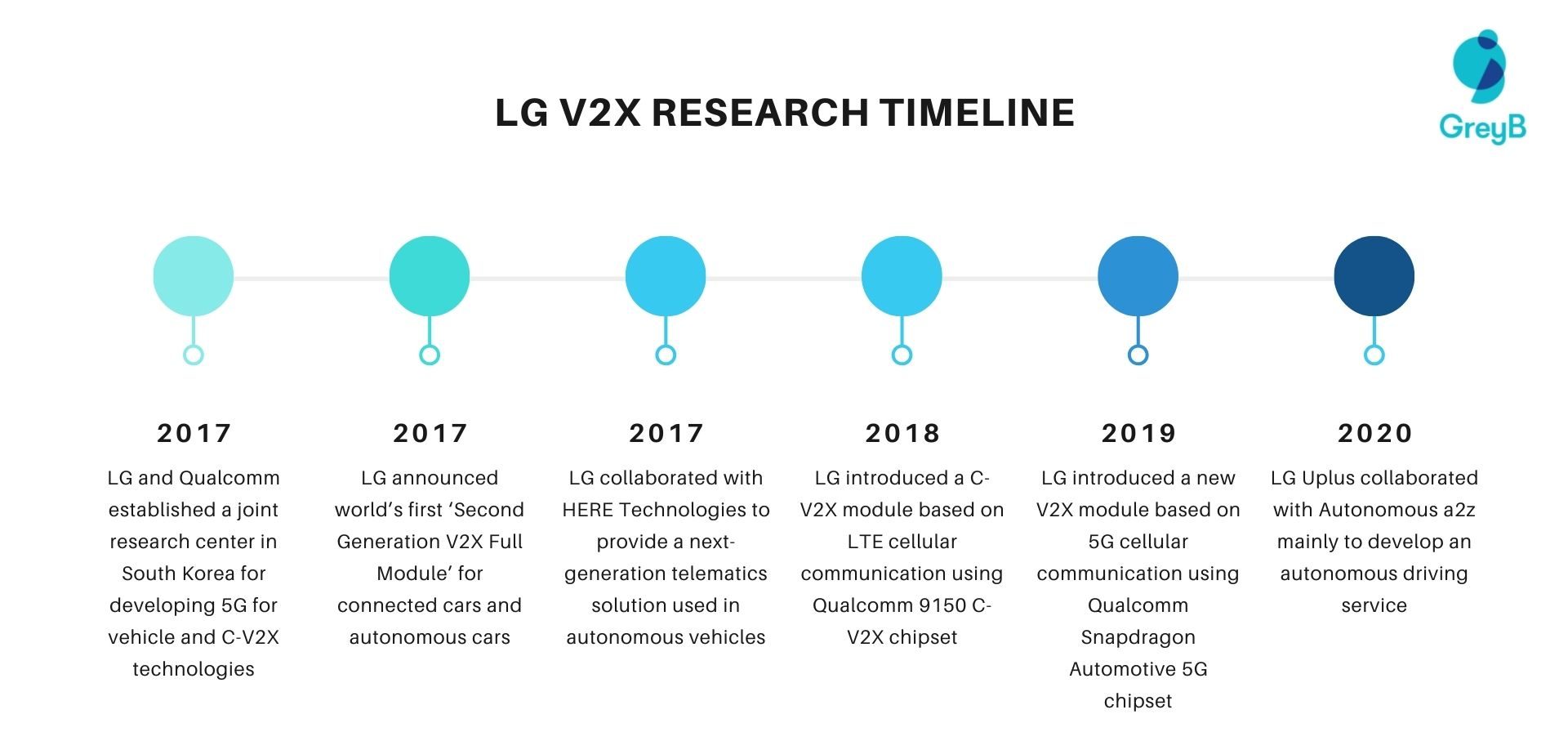 Collaborations
Collaborations
In 2017, LG collaborated with HERE Technologies to provide a next-generation telematics solution used in autonomous vehicles. The solution comprises two things, i.e. high-precision map data and location services of HERE Open Location Platform, with the advanced telematics technology of LG. The sensors in the vehicle’s ADAS capture the surrounding environment and send the data to the cloud along with information on nearby vehicles that is collected through V2X.
In 2019, LG collaborated with Qualcomm mainly to develop a 5G for vehicles and C-V2X technology. The 5G platform will be able to connect vehicles to nearby base stations and perform various next-generation functions. The various functions include smart navigation, real-time broadcasting, and making emergency calls through in-vehicle communication.
In 2020, LG Uplus collaborated with Autonomous a2z mainly to develop an autonomous driving service. LG Uplus will be providing its 5G network, dynamic map, and real-time kinematic solutions. Its V2X solutions will be providing security to the platform while laying the foundation for commercialization.
2. Qualcomm
To drive globally the C-V2X momentum, Qualcomm Technologies has been working closely with automakers, road operators, regulators, and government bodies worldwide. In 2017, the company announced its first C-V2X commercial solution i.e., the Qualcomm 9150 C-V2X chipset, which is expected to be commercially deployed in cars by 2021.
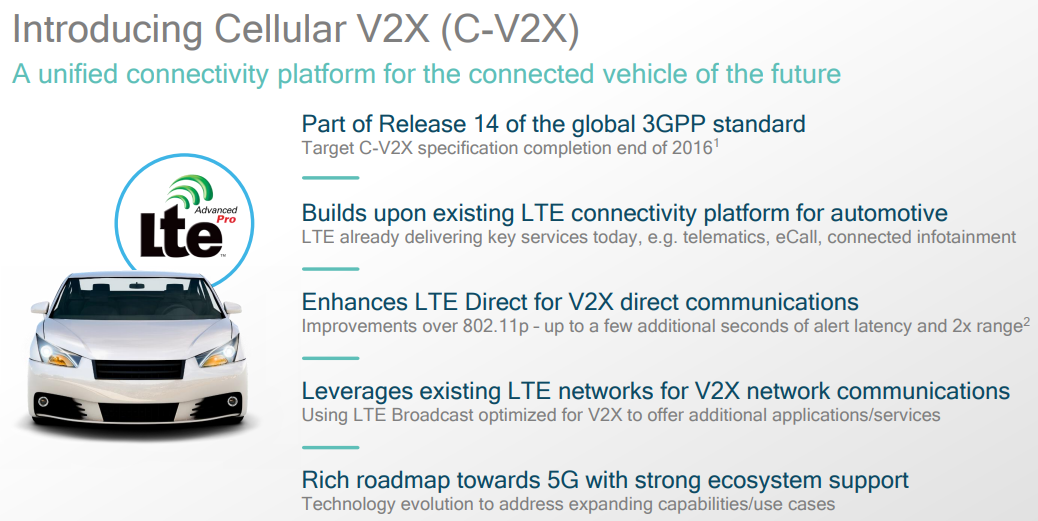 Source: Qualcomm
Source: Qualcomm
Even to conduct extensive and objective tests comparing DSRC and C-V2X, Qualcomm Technologies worked with Ford and 5GAA. Here, C-V2X demonstrated superior performance and reliability as compared to DSRC.
“In the past few months, we have seen tremendous momentum for C-V2X around the world. Thanks to our joint efforts with leading automotive and infrastructure companies, there are now multiple RED-certified C-V2X products, which paves the way to C-V2X commercialization in Europe.”
– Dino Flore, Vice-President of Technology at Qualcomm Europe
Products
Qualcomm 9150 C-V2X ASIC

The Qualcomm® 9150 C-V2X ASIC chipset is compatible with 5G and other Advanced Driver Assistance Systems (ADAS) sensors. The chipset also supports PC5 direct communication, Qualcomm Dead Reckoning 3.0, and 5.9 GHz ITS spectrum.
With such support, it can provide a range, reliability, and performance advantage compared to other similar radio technology. This features the 9150 C-V2X chipsets which are integrated with GNSS capability and include an application processor running the Intelligent Transportation Systems (ITS) V2X stack and a Hardware Security Module (HSM). It helps to accelerate the automotive ecosystem for commercial readiness.
Snapdragon Automotive 4G Platform
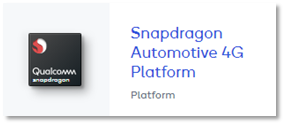 The Qualcomm® Snapdragon™ Automotive 4G Platform is a 6th generation multimode LTE modem with integrated C-V2X technology for automotive. The benefits of these platforms include precise positioning, multi-gigabit cloud connectivity, vehicle-to-vehicle (V2V), and vehicle-to-roadside infrastructure (V2I) communications for safety, high bandwidth, and low latency teleoperations support.
The Qualcomm® Snapdragon™ Automotive 4G Platform is a 6th generation multimode LTE modem with integrated C-V2X technology for automotive. The benefits of these platforms include precise positioning, multi-gigabit cloud connectivity, vehicle-to-vehicle (V2V), and vehicle-to-roadside infrastructure (V2I) communications for safety, high bandwidth, and low latency teleoperations support.
Snapdragon Automotive 5G Platform
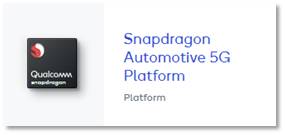 The Qualcomm® Snapdragon™ Automotive 5G Platform is 3GPP Release 15-compliant 5G multimode modem supporting 5G, LTE, 3G, 2G connectivity, concurrent with C-V2X, DSDA, and location services. The benefits of this platform include precise positioning, multi-gigabit cloud connectivity, vehicle-to-vehicle (V2V), and vehicle-to-roadside infrastructure (V2I) communications for safety, high bandwidth, and low latency teleoperations support.
The Qualcomm® Snapdragon™ Automotive 5G Platform is 3GPP Release 15-compliant 5G multimode modem supporting 5G, LTE, 3G, 2G connectivity, concurrent with C-V2X, DSDA, and location services. The benefits of this platform include precise positioning, multi-gigabit cloud connectivity, vehicle-to-vehicle (V2V), and vehicle-to-roadside infrastructure (V2I) communications for safety, high bandwidth, and low latency teleoperations support.
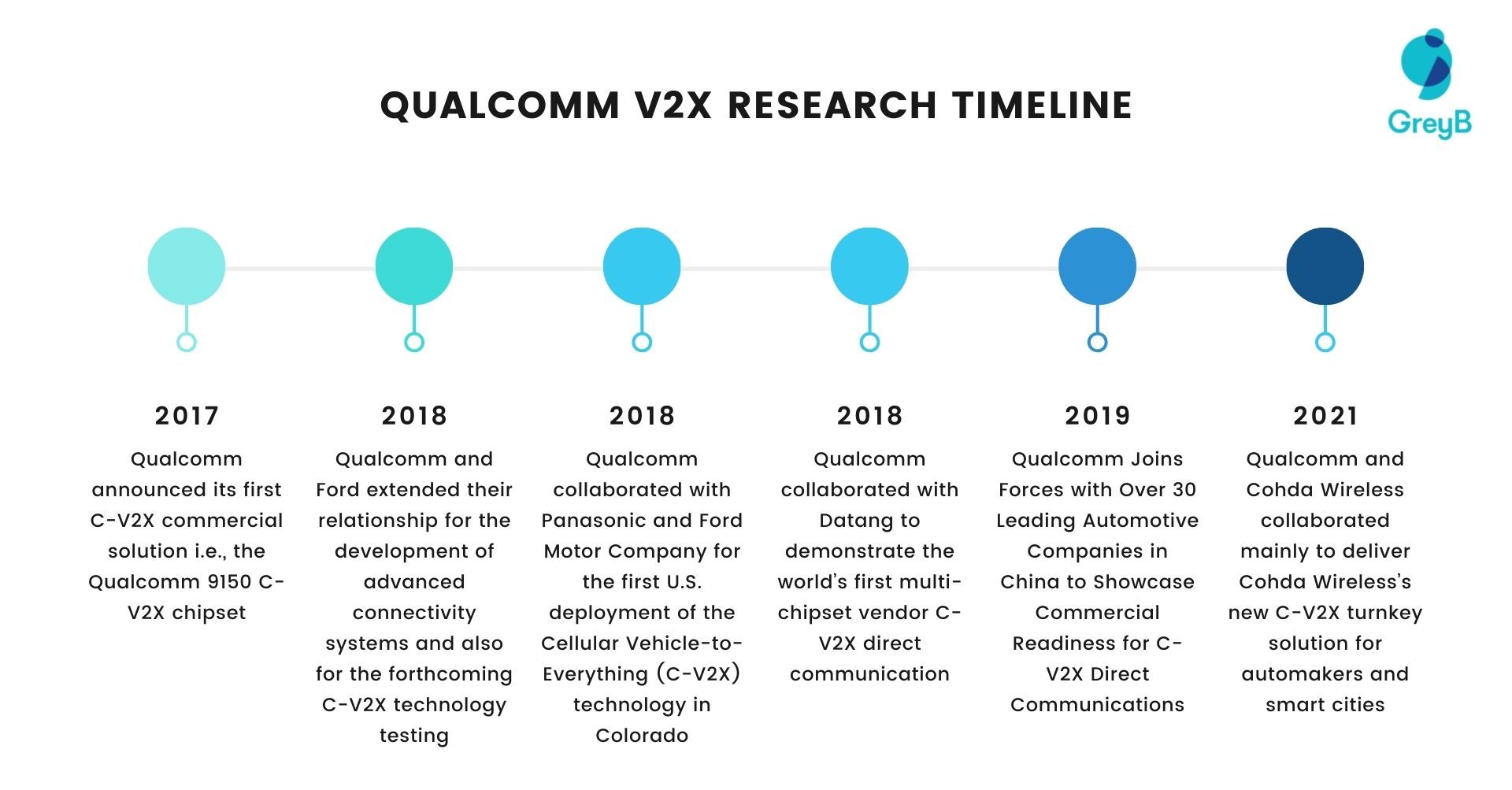 Collaborations
Collaborations
In 2018, Qualcomm Technologies and Ford Motor Company extended their relationship for the development of advanced connectivity systems for Ford vehicles and also for the forthcoming C-V2X technology testing. The Qualcomm 9150 C-V2X chipset was used for the trials in San Diego and Detroit. It uses a direct communication mode, as C-V2X is designed to empower vehicles to communicate directly with other walker devices, vehicles, and roadside infrastructure.
In 2018, Qualcomm Technologies collaborated with Panasonic and Ford Motor Company for the first U.S. deployment of the Cellular Vehicle-to-Everything (C-V2X) technology in Colorado. Even the Colorado Department of Transportation (CDOT) invested $70 million in connected vehicles through its partnership with Panasonic and other partners.
In 2020, Qualcomm Technologies, Inc. Audi of America, American Tower Corporation, and the Virginia Department of Transportation (VDOT) collaborated for the introductory deployment of the C-V2X technology in Virginia. The main aim was to improve the work zone and vehicle safety for the roads in Virginia. The companies have been working with the Virginia Tech Transportation Institute (VTTI) and V2X solutions provider Commsignia, on the initial deployment.
In 2021, Qualcomm and Cohda Wireless collaborated mainly to deliver Cohda Wireless’s new C-V2X turnkey solution for automakers and smart cities worldwide. The Qualcomm Snapdragon Automotive 5G and 4G platforms provide support to the V2X software of Cohda Wireless. The V2X solution of Cohda Wireless supports two radio communications technologies globally.
In 2021, Qualcomm Technologies, Inc. and General Motors announced to continue their collaboration for delivering premium experiences to forthcoming vehicles. Qualcomm Technologies have been working with GM to deliver power digital cockpits, next-generation telematics systems, and advanced driver assistance systems (ADAS). GM mainly worked with Qualcomm Technologies for its C-V2X technology.
3. Huawei
Huawei started the research for V2X in 2016. The Chinese giant has been collaborating with telecom giant Vodafone for a long time to provide the future connected car experience.
Huawei and Vodafone first showcased the connected car experience at MWC 2017. Using Cellular V2X (C-V2X), the live demonstration takes place in front of guests at the world-famous Circuit de Barcelona-Catalunya race track.
“Intelligent transport is set to be one of the key application scenarios of future mobile communication systems. With our long history of successful joint innovation, together with Vodafone, Huawei is very pleased to pioneer the Cellular V2X solution development to serve the needs of future ITS systems, and pave the way to a Better-Connected World with fully intelligent transport systems.”
– Edward Deng, President of Wireless Network Product Line at Huawei
To jointly set up the Connected Vehicle (C-V2X) Research Group, both Huawei and Hong Kong Applied Science and Technology Research Institute (ASTRI) had signed an agreement in 2018. At the World Internet of Things Expo 2018, both companies together demonstrated a series of C-V2X test cases (17 successful tests of typical application fields based on C-V2X were conducted).
In 2019, Huawei won the Best Mobile Technology for Automobile Award for its end-to-end C-V2X commercial solution at the 2019 World Mobile Congress. The world’s first city-level commercial C-V2X solutions were deployed in Wuxi, China, under the guidance of the Wuxi Municipal Government, Huawei and China Mobile, and 28 other partners.
During the present years, Huawei has cooperated with global and Chinese partners mainly to actively promote the C-V2X industry and technology. Huawei has been collaborating with 18 Chinese automakers and ride-hailing service providers to speed up the development of commercially available 5G-enabled cars.
Products
Huawei RSU

It is a roadside network device that is pliant with the 3GPP Release 14 LTE-V2X technology. This device provides smart transportation and autonomous driving. It also supports low-latency V2X data broadcast. It also helps operators coordinate with connected vehicles, improve transportation efficiency, and ensure transportation safety.
Huawei T-Box
 Huawei has developed a city-level C-V2X network in Wuxi. It is composed of RSUs and T-Boxes which are integrated with HiSilicon chips. The T-Box provides E2E C-V2X solutions. It helps to develop V2X applications on the T-Box using Huawei APIs for differentiated design.
Huawei has developed a city-level C-V2X network in Wuxi. It is composed of RSUs and T-Boxes which are integrated with HiSilicon chips. The T-Box provides E2E C-V2X solutions. It helps to develop V2X applications on the T-Box using Huawei APIs for differentiated design.
C-V2X Chipset (Balong 765)
 Huawei has made great progress in C-V2X and has disclosed the C-V2X chip. In 2019, Huawei launched the 5G in-car module MH5000. Balong 765 is the first chip to support LTE Cat.19 worldwide.
Huawei has made great progress in C-V2X and has disclosed the C-V2X chip. In 2019, Huawei launched the 5G in-car module MH5000. Balong 765 is the first chip to support LTE Cat.19 worldwide.
V2X Antenna
The V2X Antenna’s performance is optimized to deliver omnidirectional coverage, with at least 300 meters of direct coverage and at most 1200-meter LOS.
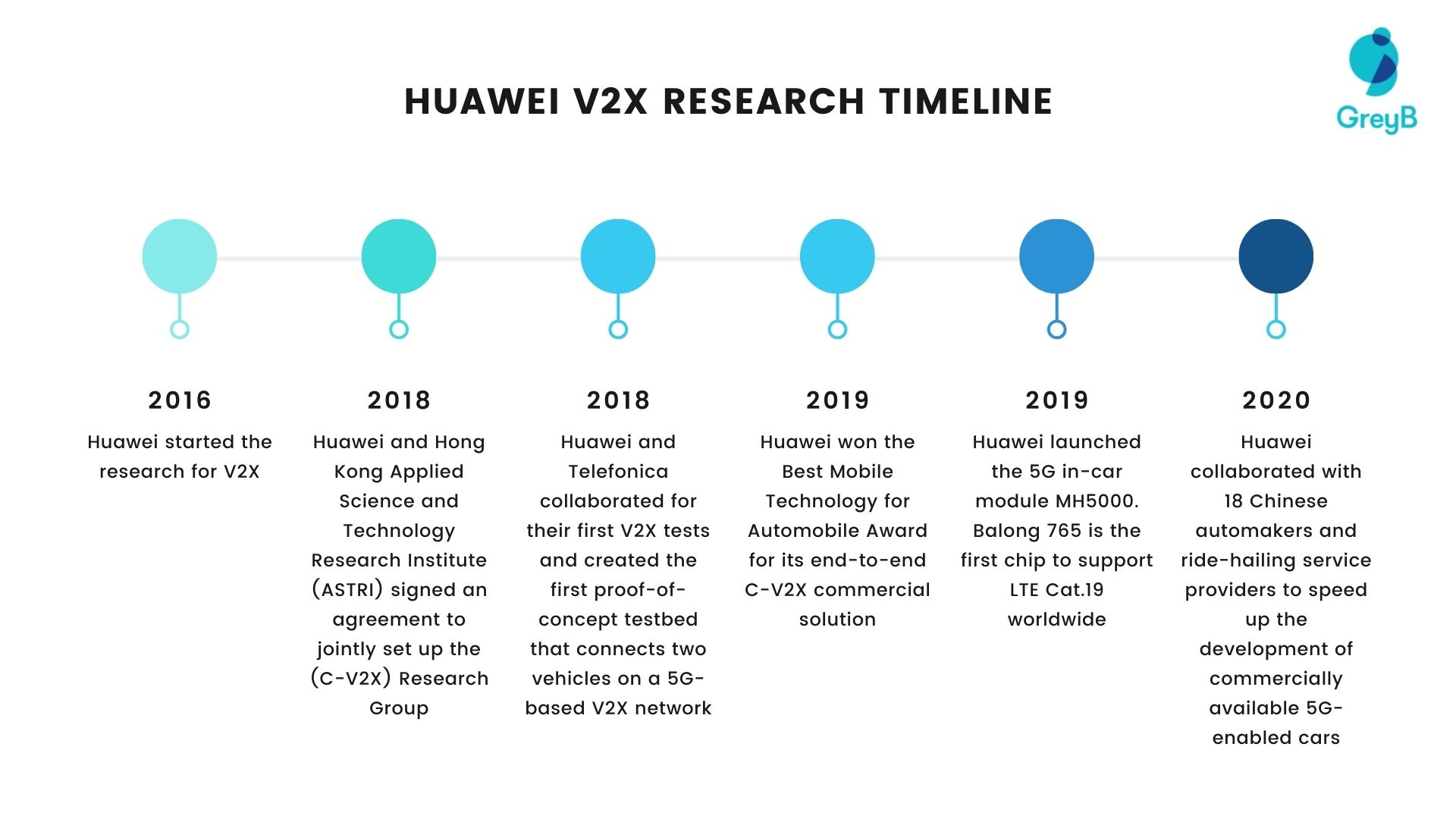
Collaborations
In 2018, Huawei, Vodafone Germany, and Bosch collaborated to successfully test the extended use of C-V2X R14, together with Bosch’s Adaptive Cruise Control (ACC) driver assistance system. The real-time integration of C-V2X with the ACC driver assistance system will provide more efficient and safer driving.
In 2018, Huawei, Vodafone, and Jaguar Land Rover jointly collaborated as the companies presented their C-V2X technology, as this technology aimed to enhance road safety in London. The C-V2X had been built on Jaguar’s F-Pace and Land Discovery cars which are powered by Huawei’s chips that support short and long-range mobile communications.
In 2018, Huawei and Telefonica collaborated for their first V2X tests. They had created the first proof-of-concept (PoC) testbed that connects two vehicles on a 5G-based V2X network. The applications of the 5G-V2X services include extended sensors, advanced driving and remote parking, and many more.
In 2020, Huawei collaborated and partnered with 18 Chinese automakers and ride-hailing service providers to speed up the development of commercially available 5G-enabled cars. The C-V2X technology of Huawei will be combining communications through cellular networks for cloud-based services such as navigation and infotainment with direct link communications with other vehicles, smart infrastructure, and pedestrians.
In 2020, Huawei Technologies Co., Ltd., and Chery Automobile Co., Ltd. collaborated with a focus on business development related to cloud computing, big data, and smart car solutions. Both companies will explore 5G-based innovative application scenarios while also developing the technologies of 5G+V2X, vehicle-infrastructure cooperation, and autonomous driving.
4. Hyundai
Hyundai has concentrated its energies and R&D expertise on the advancement of next-generation innovations focused on automobile IT, such as V2X, to lead the way in future mobility innovation. Hyundai anticipates that the amount of information shared for V2X would be massive. They have been concentrating their development capabilities on experimental studies for V2X focused on 5G connectivity for this purpose. They also want to advance their technology to the point that they can assist in driving the car, taking over control of the vehicle in a risky situation, rather than merely displaying warning signs to the drivers.
Products
Integrated Communication Controller
 In Jun 2020, Hyundai Mobis announced that it has developed the Integrated Communication Controller, which enables real-time communication of various vehicle information with other vehicles or infrastructure through external communication networks.
In Jun 2020, Hyundai Mobis announced that it has developed the Integrated Communication Controller, which enables real-time communication of various vehicle information with other vehicles or infrastructure through external communication networks.
The Communication Controller manages massive volumes of data in real-time. It also integrates connected car services, like remote vehicle control and automated software updates for different applications, eCall, which remotely transmits collision reports in the event of an emergency.
It succeeded in localizing the core connected car technology that connects vehicles, people, things, and infrastructure with high-speed communication networks. It is expected that various kinds of vehicle and driver data will be utilized to apply a wider range of services that provide safety and convenience.
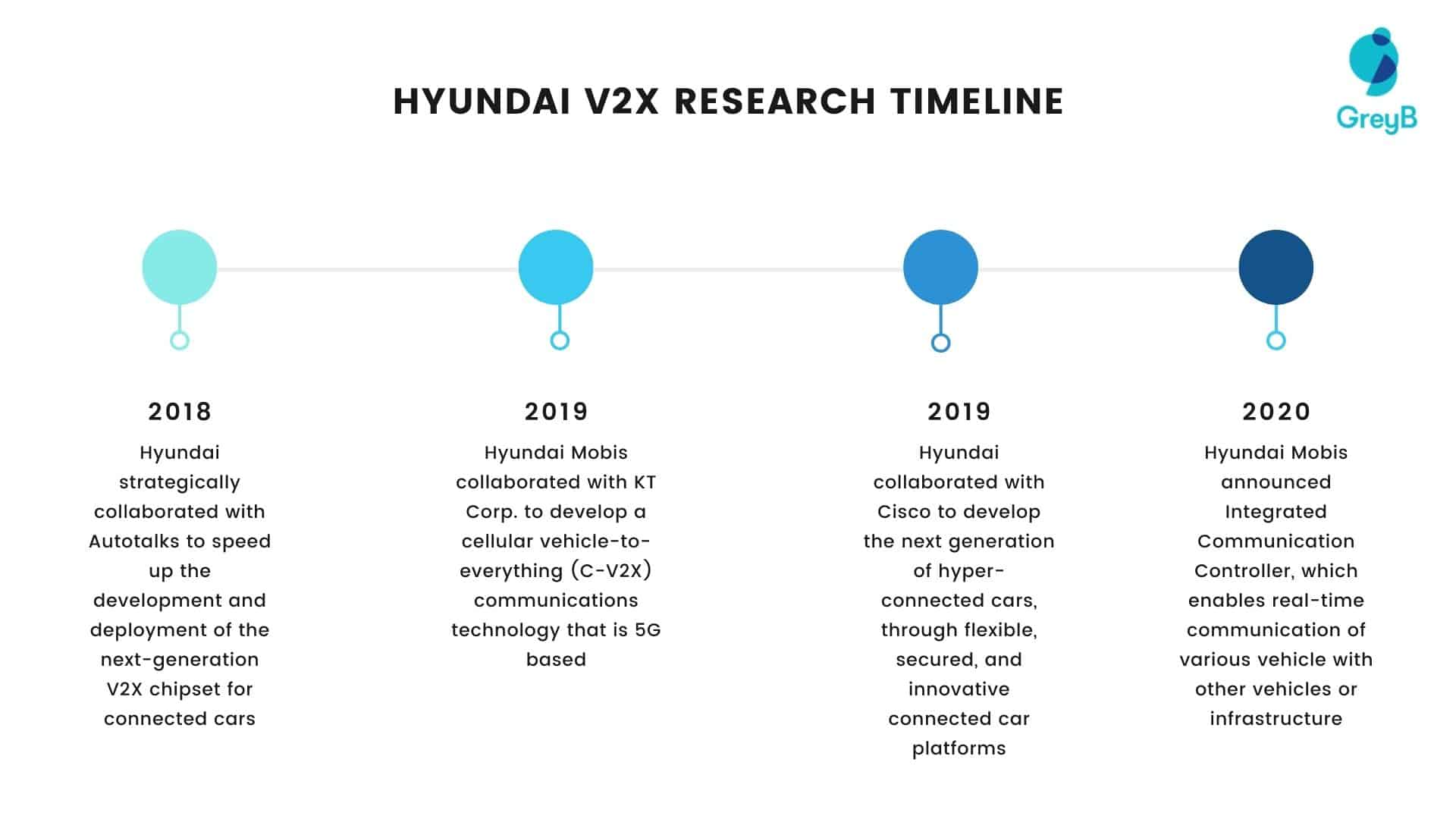
Collaborations
In 2018, Hyundai strategically collaborated with Autotalks to speed up the development and deployment of the next-generation V2X chipset for connected cars. This technology helps to improve vehicles and road safety, and mobility and is important for autonomous driving. Hyundai has been expanding its partnerships to strengthen connectivity technology that is important to autonomous driving.
“Connectivity is one of the core technologies that can be applied to smart city business models, as well as autonomous driving and infotainment. Hyundai Motor will continue to invest in disruptive technologies that are in line with Hyundai’s current and future strategic pillars.”
– Yunseong Hwang, Director of open innovation business group, Hyundai Motor.
In 2019, Hyundai Mobis collaborated with KT Corp. to develop a cellular vehicle-to-everything (C-V2X) communications technology that is 5G based. They had started using the new 5G communication network for the development of real-time navigation update technology and C-V2X-connected vehicle systems.
“As the connected vehicle is completed with organic connections with the outside world, inter-industry cooperation to preoccupy related technologies is active in this area,”
– Jang Jae-ho, Head of the Hyundai Mobis Electrical and Electronics R&D center.
In 2019, Hyundai collaborated with Cisco to develop the next generation of hyper-connected cars, through flexible, secured, and innovative connected car platforms. Hyundai Motor had ensured that its connected car infrastructure could adopt innovations in the vehicle to everything (V2X) communication. This will help the car platform to evolve and link cars to everything from homes and offices to city infrastructure and other vehicles.
5. Samsung
Samsung is strategically positioned to lay the groundwork for a modern industrial ecosystem that will enable the autonomous driving industry to thrive with its technological experience in 5G technology. The network solution in K-City, backed by Samsung and KOTSA, is built as a multi-purpose open innovation lab to serve different industries. The site would soon become a research hub for automated vehicles and connected cars, propelling the potential development of 5G industries.
At CES 2020, Samsung showcased the way to pair 5G TCU (Telematics Control Unit) with V2X technology. Even the reduced latency enabled by 5G allows for the delivery of improved driving information without any delay.
Products
5G TCU
Samsung Electronics launched Digital Cockpit in 2020. It uses 5G to attach features inside and outside the car, providing connected experiences for drivers as well as passengers. The solution provides customized interactions and in-car infotainment while enabling smooth two-way communications between the home, the workplace, and all other spaces that users can visit. When necessary, the vehicle can exchange messages and relay the driver’s position to parties outside the vehicle using V2X (Vehicle to Everything) networking technology and the Tail Display.
Dual-Mode V2X system
It has been introduced by HARMAN International, a wholly-owned subsidiary of Samsung to aim at improving automotive safety. It provides vital solutions that can help address automakers’ needs to seamlessly introduce more linked safety features. The adaptable telematics system includes both software and hardware and connects to DSRC and cellular (5G) Vehicle-to-Everything (C-V2X) networks, eliminating the need for various safety system configurations.
mmWave 5G TCU
 mmWave 5G TCU’s rapid and steady communications would open up a new range of better in-vehicle services. It allows consumers to experience both safe and enjoyable driving, as well as improved V2X (Vehicle to Everything) facilities.
mmWave 5G TCU’s rapid and steady communications would open up a new range of better in-vehicle services. It allows consumers to experience both safe and enjoyable driving, as well as improved V2X (Vehicle to Everything) facilities.
“Samsung’s Automotive mmWave 5G TCU technology will enable communication capabilities to help make driving safer, more convenient, and more enjoyable.” – Wonsik Lee, EVP Head of R&D Group for Samsung’s Automotive Electronics Business Team.
Acquisitions
In Feb 2021, Samsung’s subsidiary, HARMAN International acquired Savari, an automotive technology firm designing V2X technology for 5G Edge and automotive applications. Savari will be deploying V2X sensor solutions and edge-based analytics mainly focusing on automotive and smart infrastructure.
“Adding Savari’s MEC technology and the team of experts is an important component as we continue to build an open platform based on 5G and V2X, working with several partners across the industry to meet the unique needs of our customers globally.”
– Christian Sobottka, President, Automotive Division, HARMAN
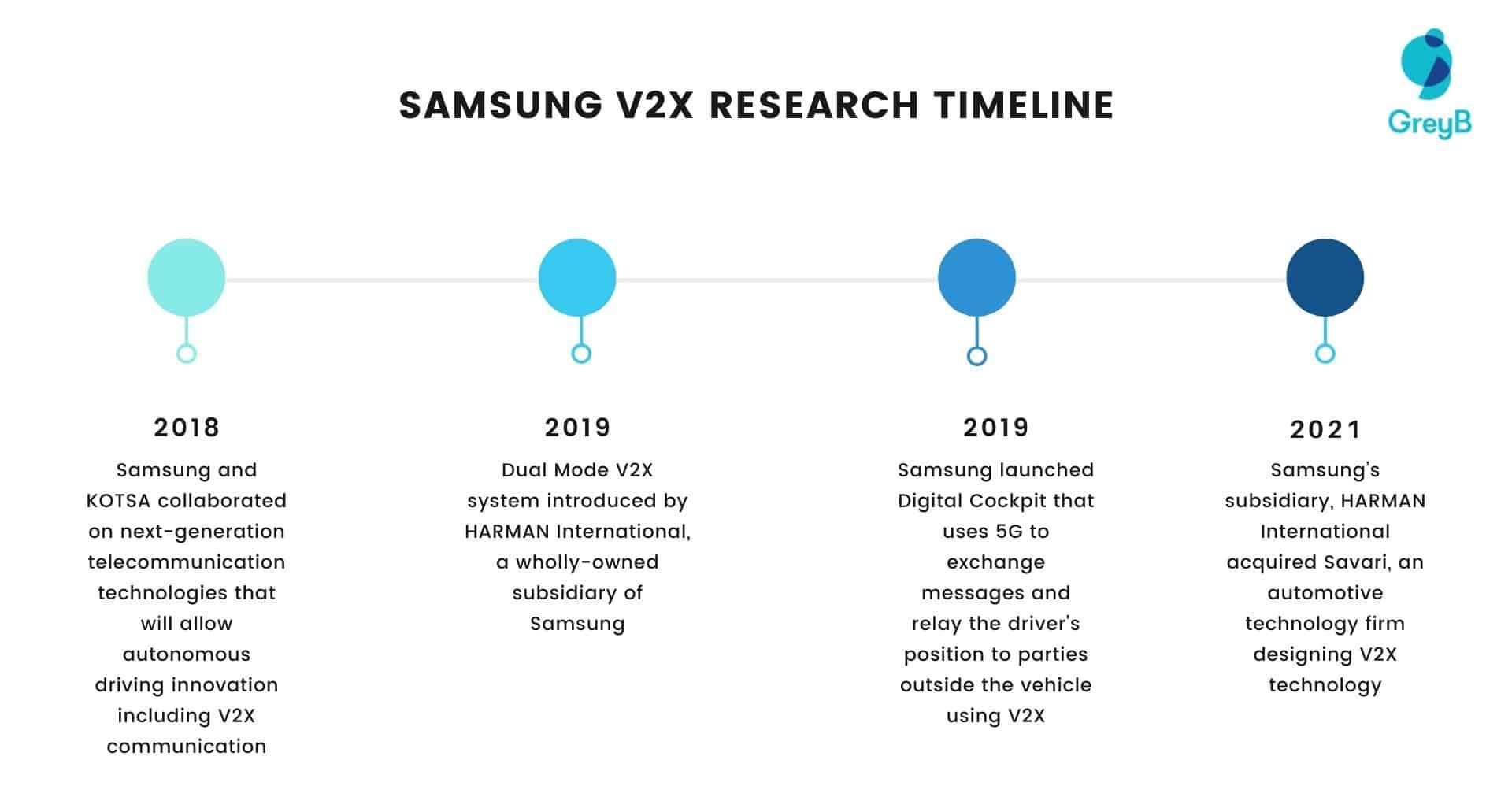
Collaborations
In 2018, Samsung and KOTSA collaborated on next-generation telecommunication technologies that will allow autonomous driving innovation across the region. Both organizations will collaborate to develop 4G LTE, 5G, and Vehicle-to-Everything (V2X) telecommunication networks, as well as related IT infrastructures, at K-City. The purpose is to make a 5G-V2X test zone for connected cars and autonomous vehicles.
“By building various telecommunication networks including 5G, 4G, and V2X in one place, K-City will provide real-world experiences of autonomous driving for people and businesses across the industry,”
–Byung Yoon Kwon, Director of KOTSA
6. Ford
Ford is the only automaker in the United States that has made a strong pledge of using V2X transmitters in upcoming versions. Ford Motor Company revealed in 2019 that it intends to begin installing cellular vehicle-to-everything, or C-V2X, technology in Ford vehicles in China in 2021.
This pledge reflects Ford’s determination to accelerate the commercial rollout of C-V2X wireless networking technologies, and it comes on the heels of the company’s intention to use C-V2X technology in all new Ford models in the United States starting in 2022. As a vital member of the 5G Automobile Association (5GAA), Ford is coordinating with industry and government agencies around the world to boost momentum for C-V2X development and implementation.
“C-V2X will live up to its full potential when enough vehicles and city infrastructure takes advantage of it. Our move to equip new Ford vehicles in China with C-V2X capability will contribute to the meaningful deployment of this advanced technology. We are dedicated to working together with the industry and government agencies globally to accelerate momentum for C-V2X, helping us deliver on our vision of ‘smart vehicles for a smart world’.”
– Don Butler, Executive Director, Ford Connected Vehicle Platform and Product
Products
Ford Co-Pilot360
Ford Co-Pilot360 is a series of features designed to keep one in control from the driveway to the highway. Ford uses C-V2X technology with its new Ford Co-Pilot360 series of features and another driver-assist technology allows vehicles to collect information about hazards and situations and react appropriately.
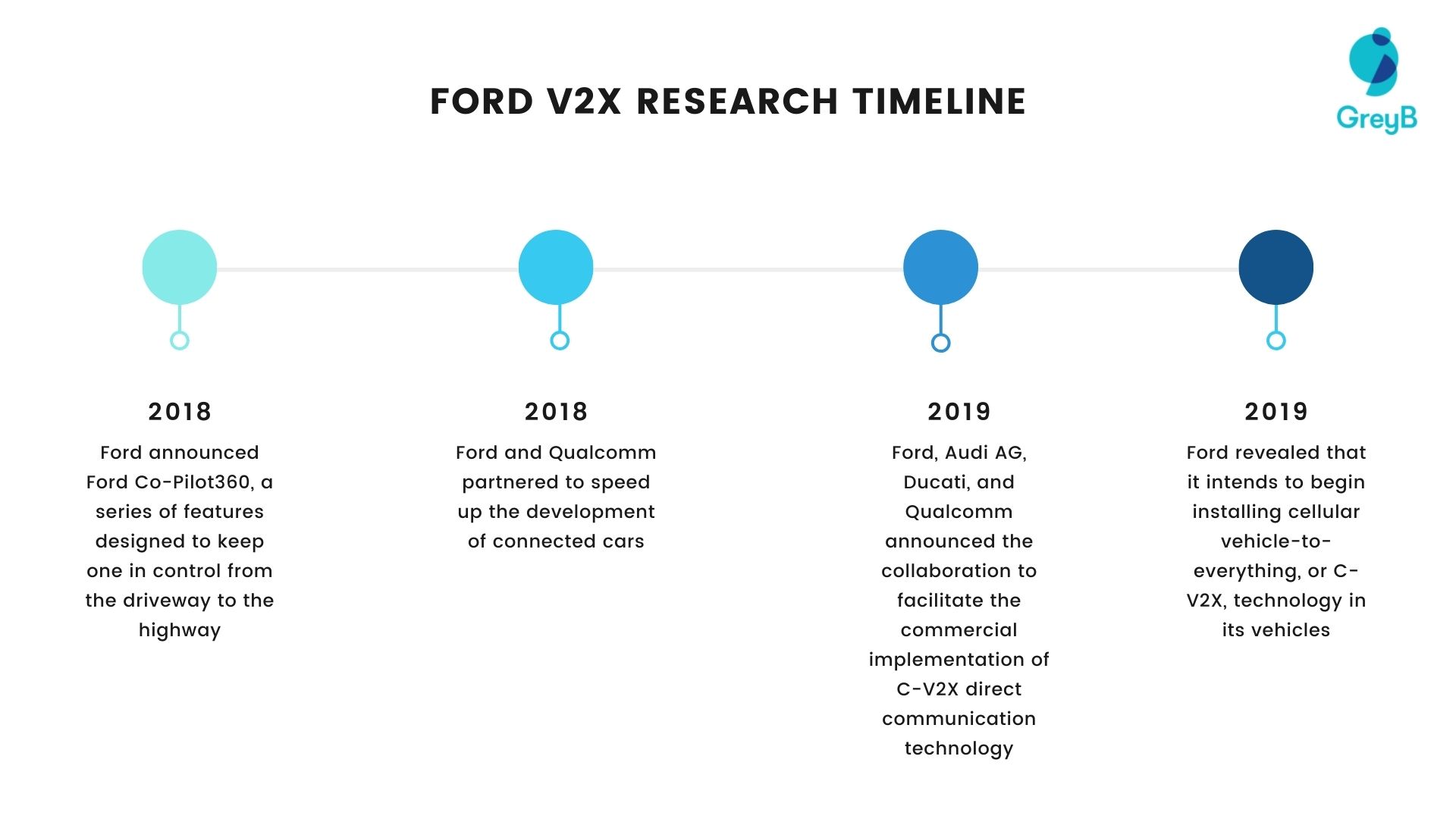
Collaborations
In 2018, with the expansion of their longstanding partnership into the advancement of integrated communications solutions for Ford vehicles and future Cellular Vehicle-to-Everything (C-V2X) technology trials, Ford and Qualcomm Technologies partnered to speed up the development of connected cars.
In 2018, Ford, Panasonic, and Qualcomm announced a collaboration to assist with the deployment of the technology and the evaluation of C-V2X capability in Colorado. The transit authority’s current fleet of Ford utility vehicles to be outfitted with C-V2X systems that will use Ficosa’s CarCom network to allow direct vehicle-to-vehicle (V2V) and vehicle-to-infrastructure (V2I) communications.
In 2019, Audi AG, Ducati, Ford, and Qualcomm Technologies announced the continuation of collaboration to facilitate the commercial implementation of C-V2X direct communication technology for roadside protection, traffic quality, and autonomous driving. To show a cooperative intersection use case, all vehicles were outfitted with C-V2X technology utilizing the Qualcomm 9150 C-V2X chipset.
“Imagine a person suddenly steps into the street from out of view and your vehicle stops because it was alerted by that person’s smartphone. This is just one example of how C-V2X can connect smart vehicles to a smart world,”
– Don Butler, executive director, Ford Connected Vehicle Platform and Product
7. Toyota
Toyota had been planning to use the dedicated short-range communication (DSRC) technology which is based on Wi-Fi, just as General Motors used it. The federal communications commission in the U.S. has set a scale in the 5.9 GHz band for connected transportation. In 2015, Toyota was the first company to deploy DSRC-based V2V communications in Japan. Around 100,000 Toyota and Lexus vehicles with V2V will be sold in China within 2018.
The V2V’s launch has been a part of Toyota’s larger commitment to safety. This includes the deployment of Toyota Safety Sense and Lexus Safety System driver-assist systems. Toyota had announced its commitment to widely deploy DSRC-based V2X communications. In 2019, Toyota had announced that it will not deploy its V2X communication technology on vehicles in the U.S. in 2021. This is mainly due to the reason “need for greater automotive industry commitment as well as federal government support to preserve the 5.9 GHz spectrum band for DSRC (Dedicated Short-Range Communications).”
“By allowing vehicles’ intelligent systems to collaborate more broadly and effectively through DSRC technology, we can help drivers realize a future with zero fatalities from crashes, better traffic flow, and less congestion.”
– Jim Lentz, CEO, Toyota North America
Products
Toyota Safety Sense ITS Connect
ITS Connect is a system created in the hope of creating a world with no road fatalities in which anyone can travel safely and securely. It promotes careful driving by collecting information on the location of cars and pedestrians in the driver’s line of sight, as well as signal information that cannot be identified by the vehicle’s sensors, by interacting directly between the road and the vehicle, or between vehicles, and alerting the driver.
Communicating Radar Cruise Control
 Toyota revealed a new Communicating Radar Cruise Control that uses V2V contact to help to precede and trailing vehicles maintain a protected distance apart. The latest technology employs a forward-facing millimeter-wave radar to measure the distance between the vehicle and the one ahead, as well as their relative speeds and the acceleration/deceleration of the vehicle ahead.
Toyota revealed a new Communicating Radar Cruise Control that uses V2V contact to help to precede and trailing vehicles maintain a protected distance apart. The latest technology employs a forward-facing millimeter-wave radar to measure the distance between the vehicle and the one ahead, as well as their relative speeds and the acceleration/deceleration of the vehicle ahead.
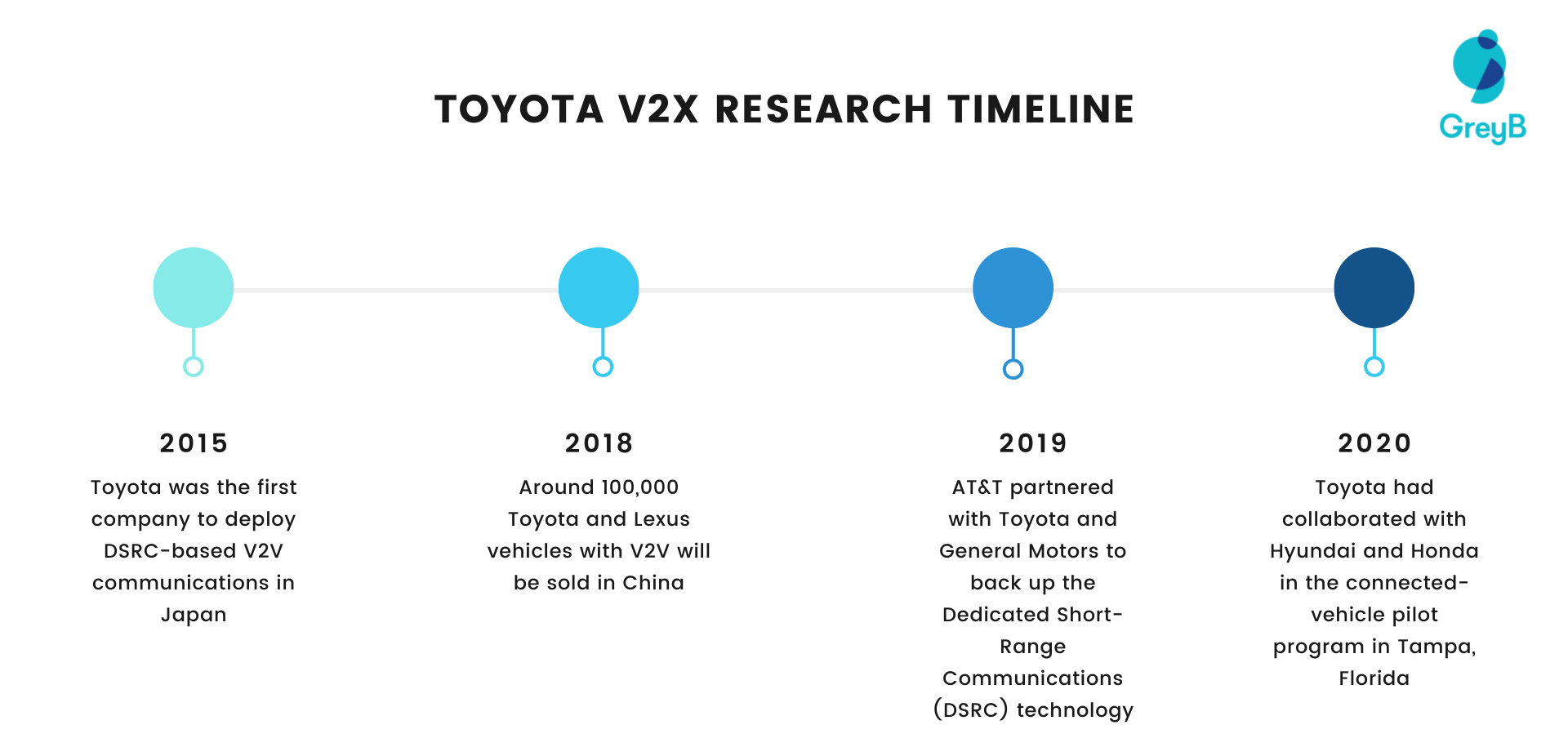 Collaborations
Collaborations
In 2019, AT&T has partnered with Toyota and General Motors to back up the Dedicated Short-Range Communications (DSRC) technology. In the US, the LTE connectivity of AT&T has been implemented on the latest model of Toyota and Lexus cars. The new deal will focus on AT&T’s plug into Toyota’s global communications platform, which has been developed with KDDI. KDDI is a technology to improve in-car streaming and browsing, as well as vehicle diagnostics, navigation, and connected safety.
In 2020, Toyota collaborated with Hyundai and Honda in the connected-vehicle pilot program in Tampa, Florida. The companies together will be deploying vehicles with connected vehicle technology that has been installed already. Toyota has been excited to support the V2X deployment initiative in Tampa, as the achievement of cooperative transportation systems, with V2X technologies, is important for creating a more safe and more eco-friendly mobility future.
8. General Motors
In 2014, General Motors demonstrated the future of automated driving and connected mobility at the Intelligent Transport Systems (ITS) World Congress. An automated Chevrolet EN-V 2.0 concept vehicle, an Opel Insignia research vehicle, and Chevrolet Cruze equipped with vehicle-to-pedestrian (V2P) connectivity were exhibited on Belle Isle. GM demonstrated other potential uses of V2X communication technology by demonstrating a Chevrolet Cruze equipped with vehicle-to-pedestrian (V2P) communication technology.
General Motors had committed to launching the connected vehicle (V2X) technology to the market. In China, the company had been promoting the adoption of dedicated short-range communications (DSRC). To improve driver safety, both vehicle-to-vehicle (V2V) and V2X technologies are important. The DSRC technology allows vehicles to communicate with each other while reducing crashes. GM has been collaborating with other companies mainly to help deploy and establish DSRC standards, which are ready for adoption for V2X/ V2V technologies.
Products
2021 Buick GL6 MPV
GL6 MPV, a V2X-enabled vehicle, is a refreshed version of the current-generation GL6. Buick V2X technology provides fast networking and data transfer. This enables it to examine dynamic and difficult road conditions with accuracy and dependability that reaches beyond the driver’s line of sight.
2021 Buick GL8 Avenir
The 2021 Buick GL8 Avenir’s V2X system helps vehicles to connect with one another and with traffic networks, helping to improve protection and minimize congestion. This system is compatible with eight V2V and V2I applications and provides high-speed data transfer and connectivity. This enables precise and reliable real-time analysis of the dynamic road landscape, alerting the driver of any possible safety risks.
2017 Cadillac CTS
The 2017 Cadillac CTS sedan comes standard with industry-leading vehicle-to-everything (V2X) technology. The V2X equipment gives the car ‘360͒ vision’ by collecting and synthesizing data from sensors on surrounding vehicles and roadside facilities to identify unknown hazards, stretching the horizon of awareness beyond what the driver can see.
Super Cruise
Super Cruise is a truly hands-free freeway driver assistance feature. Cadillac contributed to creativity and made consumers’ lives easier by the expansion of Super Cruise and V2X communications technology. Super Cruise software uses an internal camera to track the human driver and alerts them if the driver is too distracted. If a driver seems to be intoxicated, the vehicle will come to a halt and notify authorities via OnStar.

Collaborations
In 2016, General Motors collaborated with the Shanghai International Auto City, China Academy of Information and Communications Technology (CAICT), Tsinghua University, Yanfeng Visteon, and Chang’an Auto to show data exchange application layer standards of the China connected vehicle (V2X). The technology aids in the prevention of accidents and the enhancement of performance. The main aim of V2X connectivity is to improve highway safety and reduce traffic congestion.
“We are stepping up the development of ICV technologies specifically for China. Our first V2X-enabled vehicle, a Buick GL8, will be introduced later this year. In 2022, 5G will be capable on all-new Cadillac and most Buick and Chevrolet models going forward.”
– Ken Morris, Vice President of Autonomous and Electric Vehicle Programs, General Motors
In 2021, General Motors and Qualcomm Technologies continued to collaborate to offer luxury experiences in future vehicles. They continued to collaborate to include automated cockpits, next-generation telematics services, and potential advanced driver assistance systems (ADAS) to upcoming vehicles. As part of the relationship, GM partnered with Qualcomm Technologies on C-V2X, which debuted with the Buick GL8 MPV sold in China.
Acquisitions
In 2016, GM purchased Cruise, a software firm that it believes would aid in the advancement of autonomous vehicle technology. Cruise experiments and advances self-driving vehicle technologies. It began by focusing on direct-to-consumer kits for retrofitting cars with minimal self-driving capability. It encourages vehicle owners to participate in joint ownership rather than sole ownership to minimize environmental pollution, the number of injuries, and traffic congestion in major cities.
Conclusion
As we said above, technology companies are leading the V2X research. And given the expertise and the adoption of C-V2X, it makes total sense. But that doesn’t mean that automakers are losing. V2X is a big part of autonomous driving solutions. And the autonomous industry is dependent on both technology and automotive companies.
It is difficult for automotive companies to research on the same level as technology companies for a technology in which they have been working for many years and vice versa.
Building a car might not need R&D but its mass production still needs heavy investment and effort.
Elon Musk recently replied to a tweet that says the same thing.

So, although automakers are behind in V2X that might not be a major concern for them. There is always an option to acquire a startup or a well-organized business unit for a company.
Recently, Woven Planet, a subsidiary of Toyota acquired Lyft’s self-driving division for $550 million.
And, besides the tech and automotive giants, many startups are contributing a lot to the autonomous sector. And V2X technology also has some startups that are worth noticing. Big companies like Qualcomm have collaborated with them for the technology.
In the last part of the series, we will discuss top V2X startups that might be useful and worth acquiring for a tech or automotive company to take a lead in the V2X market.








